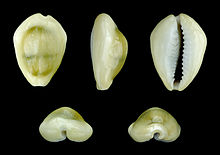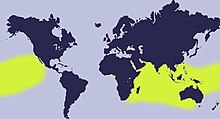Monetaria moneta: Difference between revisions
m Bot: Migrating 6 interwiki links, now provided by Wikidata on d:q1314137 (Report Errors) |
|||
| Line 93: | Line 93: | ||
[[Category:Animals described in 1758]] |
[[Category:Animals described in 1758]] |
||
[[fr:Cypraea moneta]] |
|||
[[lt:Monetinė kaurė]] |
|||
[[ja:キイロダカラ]] |
[[ja:キイロダカラ]] |
||
[[pl:Cypraea moneta]] |
|||
[[th:หอยเบี้ยจักจั่น]] |
|||
[[vi:Monetaria icterina]] |
|||
[[zh:货贝]] |
|||
Revision as of 12:57, 26 February 2013
| Money cowry | |
|---|---|

| |
| The underside of a live Monetaria moneta with the mantle partially retracted | |

| |
| Five views of a shell of Monetaria moneta | |
| Scientific classification | |
| Kingdom: | |
| Phylum: | |
| Class: | |
| (unranked): | |
| Superfamily: | |
| Family: | |
| Genus: | |
| Species: | M. moneta
|
| Binomial name | |
| Monetaria moneta | |
| Synonyms[1][2] | |
| |
Monetaria moneta, common name the money cowry, is a species of small sea snail, a marine gastropod mollusk in the family Cypraeidae, the cowries.[1]
This species is called "money cowry" because the shells were historically widely used in many Pacific and Indian Ocean countries as a form of exchange before coinage was in common usage.
Subspecies and forms
Subspecies:
- Monetaria moneta barthelemyi (f) Bernardi, M., 1861 [3]
Forms:
- Monetaria moneta form erosaformis[4]
- Monetaria moneta form harrisi Iredale, T., 1939 [5]
- Monetaria moneta form icterina Lamarck, J.B.P.A. de, 1810 [6]
- Monetaria moneta form rhomboides Schilder, F.A. & M. Schilder, 1933 [7]
- Monetaria moneta form tuberculosa Quoy, J.R.C. & J.P. Gaimard, 1834 [8]
Distribution

This is a very common species which is found widely in Indo-Pacific tropical waters. It is present in numerous regions, including East and South Africa, Madagascar, the Red Sea and the Persian Gulf, eastern Polynesia, Galapagos, Clipperton and Cocos[disambiguation needed] islands off Central America, southern Japan, Midway and Hawaii, and northern New South Wales and Lord Howe Island.[9]
Habitat
This cowry lives in intertidal rocky areas and shallow tide pools among sea weed, coral remains, and empty bivalve shells.[9] It can be found on and under rocks in shallow water and on exposed reefs at low tide. It feeds on algae and marine vegetation growing on loose rocks and pieces of dead coral.
Shell description

The shell is small (30 to 45 mm long[9]). It is white to straw-colored.
Human uses
The shell is used in jewelry and in other decorative items such as baskets and wall hangings.
As money
Shells of this cowry were commonly used as a medium of exchange[9] in many areas of Africa, Asia and the Pacific islands until the late 19th century.
The Maldives provided the main source of cowrie shells, throughout Asia and parts of the East African coast. Huge amounts of Maldivian cowries were introduced into Africa by western nations during the period of slave trade.[10]
It was also traded to Native Americans by European settlers.
For divination
The shell is still used in divination rituals by some African animist tribes.[9]
In the State of Kerala, in India, special money cowry shells (which are known in Malayalam as Kavidi കവിടി) are used for divination as part of Hindu astrology, as Prashnam. For Prashnam, 108 shells of Monetaria moneta are rotated a number of times and the blessings of God and one's Guru are invoked. A portion of the Kavadis are separated and counted to find out the ruling planet at that time. The results of the Prasna horoscope (a horoscope formulated at the time of arrival of the persons) are compared with the results of the Prasnam, and the predictions are pronounced on that basis.
References
- ^ a b WoRMS : Monetaria moneta; accessed : October 20, 2010
- ^ Gastropods.com : Monetaria moneta; accessed : 20 October 2010
- ^ Gastropods.com : Monetaria moneta barthelemyi; accessed : October 20, 2010
- ^ Gastropods.com : Monetaria moneta erosaformis; assessed : October 20, 2010
- ^ Gastropods.com : Monetaria moneta harrisi; accessed : October 20, 2010
- ^ gastropods.com : Monetaria moneta icterina; accessed : October 20, 2010
- ^ Gastropods.com : Monetaria moneta rhomboides; accessed : October 20, 2010
- ^ Gastropods.com : Monetaria moneta tuberculosa; accessed : October 20, 2010
- ^ a b c d e Poutiers, J. M. (1998). Gastropods in: FAO Species Identification Guide for Fishery Purposes: The living marine resources of the Western Central Pacific Volume 1. Seaweeds, corals, bivalves and gastropods. Rome, FAO, 1998. page 503.
- ^ Hogendorn, Jan and Johnson Marion: The Shell Money of the Slave Trade. African Studies Series 49, Cambridge University Press, Cambridge, 1986.
- Verdcourt, B. (1954). The cowries of the East African Coast (Kenya, Tanganyika, Zanzibar and Pemba). Journal of the East Africa Natural History Society 22(4) 96: 129-144, 17 pls.
